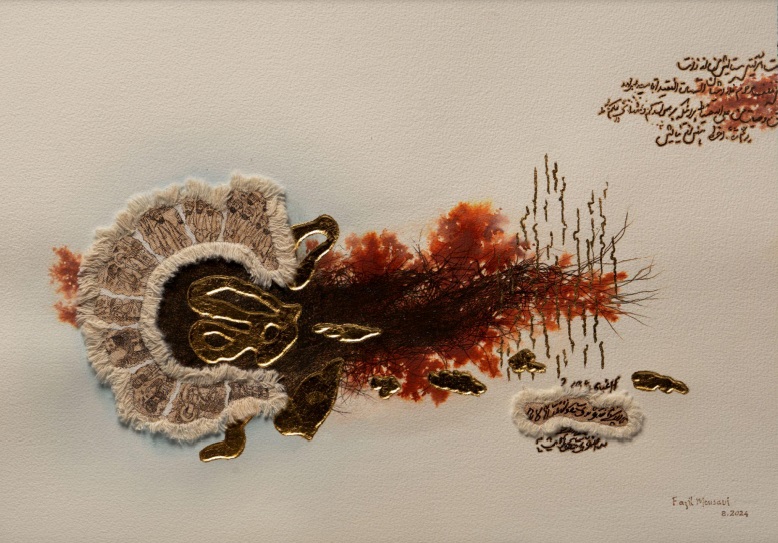
Written by: Muhammad Hamza
Posted on: February 03, 2025 |  | 中文
| 中文
Aadmi Deed Ast (A human is (nothing but) vision)
In times like these, it’s rare to unravel the truths from excerpts of a book into some visuals, but Fazil Mousavi has showcased the Shahnameh at Chawkandi Art Gallery, Karachi.
As Amra writes in her descriptive context, The Shahnameh, or The Book of Kings, is an epic poem written by the Persian poet Ferdowsi between c. 977 and 1010 CE and is the national epic of Greater Iran. Consisting of 50,000 couplets, the Shahnameh is one of the world’s longest epic poems created by a single author.
Mousavi’s expertise comes from his interest in Persian and Urdu poetry. His work speaks for all the details in between the lines, allowing viewers to see the Shahnameh through his perspective and perception. It’s fair to say that he has done justice to making a layman understand what it showcases within.
Amra exclaims in her curatorial context that in Mousavi's works, the current situation is ‘analogous to the persecution faced by Kaveh, a character in the Shahnameh, who raised his blacksmith apron as Derafsh-e-Kaviani (a banner of revolt), becoming a powerful symbol of protest against injustice. He would like to address intellectuals, most of whom are oblivious to the uncanny resemblance between mythological elements of the Shahnameh and modern-day challenges.
The minimal translation into English provides access to a wider audience and also makes one realize how removed we are from the source and the lack of awareness and knowledge of Urdu and Persian. The loss in translation is an important factor to consider here.
The cause of Mousavi trying his best to unlock the exclusive content through his experience was to showcase the difference that it makes when translating something so exquisitely beautiful into another language. This translation sometimes lacks the essence and depth to the point where it loses its character of being understood in its true sense.
Amra writes that Mousavi’s approach to the Shahnameh is to draw the essence of the masterpiece, as opposed to “depicting” it. The title, Hamzaad, as explained by Mousavi, in Urdu, can be translated as the inner shadow that resides in the subconscious. He weaves his narrative with restraint and subtlety, inviting us to read between the lines.
Fazil has made sure to excerpt all kinds of content, from reciting to showcasing a few analogies in the artworks that are further discussed.
1. The tea wash on this artwork brings a vintage depth, showing the original persona of this very piece. The gold leaf work on this piece, with its scene of trees blocking the breeze, reflects the artist’s talk about lacking the eeriness of the picture shown. In No. 2, the artist has explored a different structure using gold leaf, which stands out beautifully due to its simplicity and natural appearance. The structure, shaped like a heart and lit on fire, is showcased with flames created to heighten the drama around it.
2. No. 6: The abstractness surely takes over with an immersive experience for the viewer, making them feel part of this journey. The hues complement the composition, giving the viewer a better perspective of the experience, where the canvas’s miniature details are integrated.

Dilq-e-Hafiz Beh Che Arzad Beh Mesh Rangeen Kun (What is the worth of Hafez’s heart Adorn the trap with color).
3. No. 7 & 8: These two artworks resemble and complement each other through certain strokes and hues, done in an abstract style to recreate a specific feeling for the reader.
4. No. 12: The figurines have bloomed through every stage of life, showing melancholy through a few poses and placements of figures that have become a highlight. It’s one of those artworks that is the crux of the show.
Fazil Mousavi has been a delight to exhibit through his paintings and excerpts, challenging himself to push out a truer meaning than a layman could comprehend. It’s understandable when Mousavi communicates from a few different perspectives to one of the lost and important books of its time. Mousavi has graciously given the community a taste of hidden truths through a coded narrative that remains blunt yet exposed. It’s up to the viewer to perceive it, and it’s surely a challenging task to keep everyone on the same page and engage through a specific portal of understanding, ultimately making a difference for those around.
You may also like: